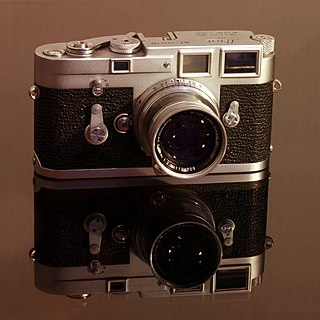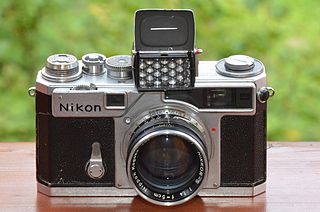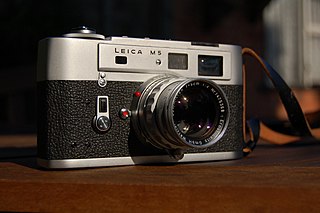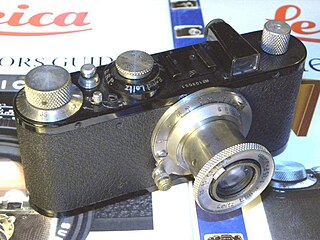Comparisons
The M2 was considered to be a more affordable, simplified version of the 1954 Leica M3. Notably, the frame counter of the M2 was composed of a disk plate beneath the film advance lever that had to be manually reset to zero after reloading. This system was close to that of the Leica III series, and unlike that of the M3, which is an independent frame counter, visible through a window in the top plate, that automatically resets to zero when the film take-up spool is removed.
The rangefinder system was also simplified from that of the M3 and this made it potentially more prone to rangefinder flare. The M2 has a rangefinder with a 0.85 magnification and framelines for 35, 50 and 90mm lenses instead of the 0.91 magnification and 50, 90 and 135mm framelines of the M3. This made it better suited for photojournalists who favour shorter lenses or for spectacle-wearers using a 50mm lens who sometimes find it difficult to see the framelines on the M3. The ground glass frameline illumination window of the M3 was replaced with a fresnel-type plastic lens. Finally, the ornate beveling around the various windows on the front of the M3 were flattened on the body of the M2. Unlike the M3, the widest framelines were not always visible so only one set of framelines were ever displayed at one time. All M2s are single stroke advance.
The M2 was followed by the still simpler Leica M1 and then the Leica M4, which used a similar rangefinder design but re-introduced the M3 style frame counter and added a faster loading system and a canted rewind lever.
On the present-day used market the M2, originally intended to be more "affordable", sells at prices only slightly lower than the M3. Both cameras are made to a similar level of quality, and the M2's framelines have proved to be more versatile over time, with all subsequent Leica rangefinder models having 35mm framelines included.

A rangefinder camera is a camera fitted with a rangefinder, typically a split-image rangefinder: a range-finding focusing mechanism allowing the photographer to measure the subject distance and take photographs that are in sharp focus. Most varieties of rangefinder show two images of the same subject, one of which moves when a calibrated wheel is turned; when the two images coincide and fuse into one, the distance can be read off the wheel. Older, non-coupled rangefinder cameras display the focusing distance and require the photographer to transfer the value to the lens focus ring; cameras without built-in rangefinders could have an external rangefinder fitted into the accessory shoe. Earlier cameras of this type had separate viewfinder and rangefinder windows; later the rangefinder was incorporated into the viewfinder. More modern designs have rangefinders coupled to the focusing mechanism so that the lens is focused correctly when the rangefinder images fuse; compare with the focusing screen in non-autofocus SLRs.

Leica Camera AG is a German company that manufactures cameras, optical lenses, photographic lenses, binoculars, rifle scopes and microscopes. The company was founded by Ernst Leitz in 1869, in Wetzlar, Germany.

Zorki is the name of a series of 35mm rangefinder cameras manufactured in the Soviet Union between 1948 and 1978.

The Leica M3 is a 35 mm rangefinder camera by Ernst Leitz GmbH, introduced in 1954. It was a new starting point for Leitz, which until then had only produced screw-mount Leica cameras that were incremental improvements to its original Leica (Ur-Leica). The M3 introduced several features to the Leica, among them the combination of viewfinder and rangefinder in one bright window, like on the Contax II, a bayonet lens mount, and rapid film advance lever. It was the most successful model of the M series, with over 220,000 units sold by the time production of the M3 model ended in 1966.

The FED is a Soviet rangefinder camera, mass-produced from 1934 until around 1996, and also the name of the factory that made it.

The Leica M6 is a rangefinder camera manufactured by Leica from 1984 to 2002.

The Leica M mount is a camera lens mount introduced in 1954 with the Leica M3, and a range of lenses. It has been used on all the Leica M-series cameras and certain accessories up to the current film Leica M-A and digital Leica M10 cameras.

The Leica CL is a 35mm compact rangefinder camera with interchangeable lenses in the Leica M-mount. It was developed in collaboration with Minolta who manufactured it. It first appeared in April 1973 and was released in the Japanese market in November 1973 as the Leitz Minolta CL. Both the Leica CL and Leitz Minolta CL were manufactured in a new Minolta factory in Osaka. In 2017, Leica announced a new digital mirrorless camera, again named Leica CL.

The Nikon SP is a professional level, interchangeable lens, 35 mm film, rangefinder camera introduced in 1957. It is the culmination of Nikon's rangefinder development which started in 1948 with the Nikon I, and was "arguably the most advanced rangefinder of its time." It was manufactured by the Japanese optics company Nippon Kogaku K. K.. Further development of Nikon's S series ended with the introduction and success of the Nikon F.

The Nikon S3 is a professional level, interchangeable lens, 35 mm film, rangefinder camera introduced in 1958. It was manufactured by the Japanese optics company Nippon Kogaku K. K..

The Konica Hexar RF is a 35 mm rangefinder camera which was sold by Konica. It was introduced to the market on 13 October 1999. and subsequently discontinued some time before the end of 2003. The camera used the "Bayonet Konica KM-mount", a copy of the Leica M-mount, thus sharing interchangeable lenses with those designed for Leica cameras and others compatible with them. The Hexar RF has a combined rangefinder/viewfinder modeled on that of Leica cameras, a similar body shape and size - and so is similar to Leica M-mount cameras in many aspects of operation.

The Bessa family of cameras is manufactured in Japan by Cosina as a revival of the Voigtländer brand name.

The Leica M4 is a 35 mm rangefinder camera produced by Ernst Leitz GmbH.

The Leica M5 is a 35 mm camera by Leica Camera AG, introduced in 1971. It was the first Leica rangefinder camera to feature through-the-lens (TTL) metering and the last to be made entirely in Wetzlar by hand using the traditional "adjust and fit" method.

The Leica MP is a 35 mm film camera manufactured by Leica Camera AG that was introduced in 2003. It is an all-mechanical rangefinder focusing camera that follows in a long line of cameras since the Leica M3 was introduced in 1954. The camera uses the Leica M-mount, which accepts all Leica bayonet-mount lenses made since 1954. The 'MP' designation stands for "mechanical perfection."

The Kodak Retina Reflex is a discontinued series of four single-lens reflex cameras made by Kodak, continuing the brand Kodak Retina.

The Leica Standard, Model E was the fourth version of the original 35 mm Leica camera to be launched from Ernst Leitz in Wetzlar, Germany. The concept was conceived by their employee Oskar Barnack in 1913. Production of the camera began in 1925 but it was not until the end of the decade that it was perfected and full-scale production was established.

The Minolta-35 was launched in the spring of 1947 by Chiyoda Kogaku. It was the first successful new 35mm rangefinder camera with Leica specifications to emerge on the market after World War II that uses the 39mm screw lens-mount. The Minolta-35 range of cameras was manufactured in quantities during its twelve-year production period, totalling about 40,000 units. Only the 1933 FED and the 1940 Leotax cameras had appeared successfully before it, although several Leica copies had appeared in both Italy and Japan.

The Kodak 35 was introduced in 1938 as the first US manufactured 35mm camera from Eastman Kodak Company. It was developed in Rochester, New York when it became likely that imports from the Kodak AG factory in Germany could be disrupted by war.

The Leicaflex series of single-lens reflex 35 mm format film cameras were introduced by Leitz Camera in 1964. The first camera body was paired with the new R bayonet series of lenses. Three model of the cameras were sold by Leitz; the Leicaflex Standard, the Leicaflex SL and the Leicaflex SL2.
























